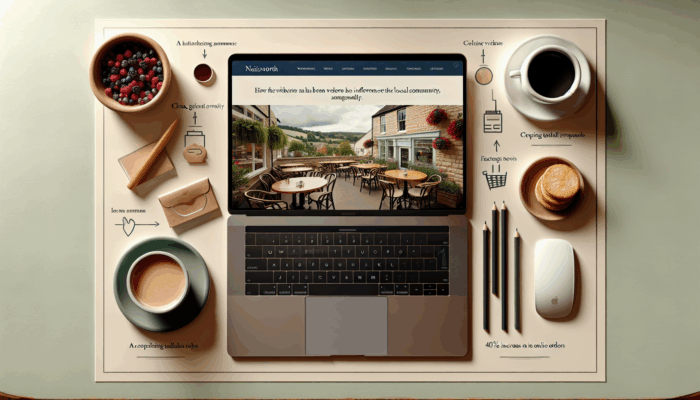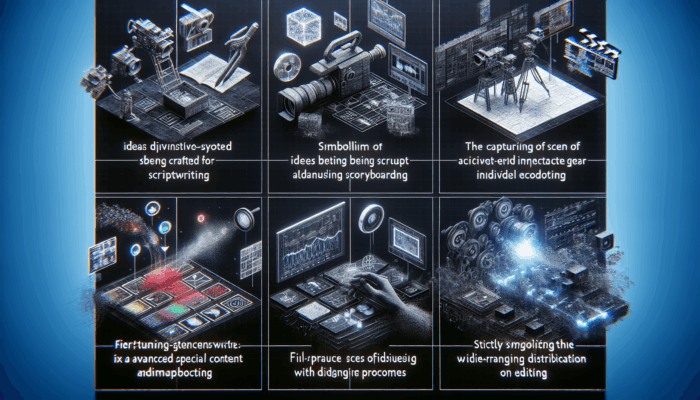Table of Contents
ToggleUncovering Innovative Trends Across Various Industries
Identifying Lucrative Market Opportunities for Business Expansion

Delving into the complexities of market trends does not require the clairvoyance of a seer; rather, it necessitates the keen observation of a committed analyst. To effectively develop content for emerging industry reports, one must hone the art of trendspotting. Start your exploration by immersing yourself in comprehensive industry analyses, diligently reading respected trade publications, and interacting with prominent thought leaders. Engaging in webinars and attending industry conferences, where pioneering innovations are frequently unveiled, can provide fertile ground for identifying the next groundbreaking opportunity.
Furthermore, harnessing the power of social media platforms is an incredibly potent strategy. Websites such as Twitter, LinkedIn, and niche forums can be treasure troves for discovering upcoming trends. By monitoring relevant hashtags, engaging in conversations, and tracking influencer insights, you can uncover vital information regarding consumer pain points and aspirations, which are essential for identifying new market opportunities. For instance, the increasing emphasis on sustainability in consumer products has significantly influenced purchasing decisions, creating fresh markets for eco-conscious alternatives.
Moreover, it is essential to utilise analytical tools such as Google Trends and keyword analytics to pinpoint what consumers are actively seeking. By meticulously analysing this data, businesses can foresee shifts in consumer behaviour long before they become widely recognised. This proactive approach empowers companies to outpace competitors and seize new opportunities, ultimately driving growth and fostering innovation within their respective sectors.
Analysing the Influence of Technological Advancements on Various Industries
The digital revolution encapsulates more than just a trendy catchphrase; it signifies a monumental shift that is reshaping industries globally. As we endeavour to develop content for emerging industry reports, it is crucial to understand the role of technology in shaping trends. From artificial intelligence to blockchain technology, technological advancements are revolutionising operational efficiencies and altering how consumers engage with brands.
For instance, in the retail sector, AI-driven analytics now facilitate hyper-personalised marketing approaches. Businesses can evaluate consumer data in real-time, enabling them to tailor promotions and product suggestions, thereby significantly enhancing the overall customer experience. Additionally, the rise of e-commerce platforms has disrupted traditional markets, making adaptability essential in this rapidly evolving landscape.
Furthermore, technology is transforming not only business operations but also the processes of report generation and distribution. Tools such as data visualisation software have converted mundane statistics into compelling graphics, promoting immediate comprehension and actionable insights. Consequently, industry reports that effectively integrate technological advancements are more influential, accelerating decision-making processes and improving overall business performance.
Investigating Changes in Consumer Behaviour and Preferences
Today’s consumers are increasingly discerning, making it essential to grasp their evolving preferences when aiming to develop content for emerging industry reports. The recent pandemic has expedited shifts in purchasing behaviours, with a significant proportion of consumers now favouring digital avenues for their convenience. This transformation necessitates a deeper examination of consumer psychology and behaviours to accurately report on industry trends.
A notable trend is the heightened emphasis on ethical consumption. Research indicates that consumers are progressively prioritising brands that align with their values, particularly in areas such as sustainability and social accountability. Companies that recognise and adapt to these shifting values can leverage them as a significant competitive advantage in the marketplace.
Cultivating engagement is paramount in this changing environment. Brands that foster a sense of community and connection via social media platforms tend to enjoy heightened customer loyalty and repeat business. By comprehending these dynamics, businesses can enhance the relevance of their industry reports and equip themselves with the insights necessary to adapt their strategies effectively.
Utilising Data-Driven Insights for Comprehensive Reporting

Collecting Relevant and Actionable Data for Insightful Reporting
In the quest for developing content for emerging industry reports, gathering pertinent data is akin to mining for precious nuggets in an expansive river of information. Start by clarifying what “relevant” entails for your specific industry—this could encompass sales figures, consumer feedback, or market share statistics.
Employing surveys and questionnaires can be a highly effective method for gathering first-hand data. By directly interacting with consumers, businesses can gain invaluable insights into their preferences and behaviours. Additionally, leveraging third-party data sources, such as market research firms or public databases, can furnish a broader contextual foundation for your findings, enhancing the richness of the overall report.
It is crucial not to underestimate the importance of qualitative data. Conducting interviews and focus groups can unveil deeper motivations and sentiments that numerical data alone may overlook. This dual approach—blending quantitative data with qualitative insights—enriches the substance of your reports, making them not only informative but also compelling and relatable to your audience.
Thoroughly Analysing Data to Reveal Emerging Trends
Data, in isolation, possesses limited value unless it is transformed into actionable insights. When scrutinising data to identify trends, the goal is to uncover patterns that tell a story. Utilise tools such as Google Analytics, Tableau, or even Excel to sift through data and visualise trends that might not be immediately apparent.
Initiate the process by categorising your data into manageable segments. Look for anomalies or spikes—these often signify emerging trends. For example, a sudden increase in sales for a specific product line could indicate a shift in consumer preferences or highlight the success of a marketing initiative.
It’s vital to remember that correlation does not imply causation; thorough analyses are essential to grasp the reasons behind identified trends. Employ statistical methods or collaborate with data analysts when necessary. The more meticulously you scrutinise your data, the more credible and actionable your industry reports will become, positioning your business as a thought leader within the sector.
Effectively Presenting Data for Maximum Engagement

Once data has been collected and analysed, the next step is presentation—often where many reports falter. Effective presentation is crucial to ensure that your audience comprehends the key insights. Thus, visual aids such as charts, graphs, and infographics become invaluable when aiming to develop content for emerging industry reports.
Utilise visuals to distil complex data into easily digestible formats. A well-crafted infographic can convey a wealth of information at a glance, facilitating readers’ absorption and retention of critical insights. Additionally, ensure that your visuals are clear and relevant; avoid unnecessary clutter, as it can distract from the principal messages you intend to communicate.
The narrative flow is equally significant as factual accuracy. Connect data points with a cohesive story, guiding the reader through the information. This storytelling approach not only boosts engagement but also reinforces the relevance of the data to real-world scenarios, thereby rendering your reports more impactful and relatable.
Interpreting Data to Guide Strategic Decision-Making
Interpreting data transcends mere number crunching; it involves translating insights into strategic actions. To effectively develop content for emerging industry reports, you must skilfully convert data into actionable recommendations that drive decision-making processes.
Begin this process by posing critical questions: What insights does this data provide regarding consumer behaviour? How can we leverage these insights to refine our product offerings or marketing strategies? Involving stakeholders in this process can be immensely beneficial. Their perspectives can refine interpretations and foster buy-in for proposed strategies, ensuring comprehensive understanding and alignment.
Furthermore, consistently revisiting your findings is essential. As new data becomes available, previous interpretations may require recalibration. Establishing a continuous feedback mechanism allows for more agile decision-making and enhances your ability to respond to evolving market conditions effectively.
Crafting Engaging and Informative Report Content
Weaving Compelling Narratives that Resonate with Readers
Effective storytelling forms the backbone of impactful reporting. When you embark on the journey to develop content for emerging industry reports, strive to weave a narrative that not only presents data but also resonates emotionally with your readers. Start with a captivating hook—an intriguing question or a surprising statistic that captures the reader’s attention.
Incorporate anecdotes and real-world examples to clarify your points. This approach not only makes your report more relatable but also aids in demystifying complex data. Ensure smooth transitions between sections by employing connective language that guides the reader through the narrative arc, facilitating a logical progression of ideas.
Additionally, clarity remains paramount. Avoid jargon unless absolutely necessary, and when technical terms are unavoidable, provide clear definitions or context. The objective is to engage a broad audience, so crafting your narrative to be accessible while retaining depth is essential for maximising impact.
Integrating Visuals to Enhance Report Engagement
Visual elements serve as more than mere embellishments; they are essential tools for clarity and engagement. In the process of developing content for emerging industry reports, integrating visuals such as graphs, tables, and infographics can significantly augment comprehension.
Charts can convert complex datasets into visual narratives, allowing readers to discern trends at a glance. Infographics can condense extensive information into digestible segments, making it easier for busy professionals to assimilate.
Remember, visuals should complement your narrative rather than overshadow it. Maintain a consistent style throughout your report, utilising colour palettes and design formats that align with your brand identity. This consistency enhances professionalism and ensures that your content remains memorable to your audience.
Customising Content to Cater to Diverse Audiences
A one-size-fits-all approach seldom proves effective in report writing. Different stakeholders possess varying interests and levels of expertise, and successfully developing content for emerging industry reports necessitates tailoring your message to meet their specific needs.
Commence by identifying the primary audiences for your report—executives, analysts, or consumers—and adjust your language, tone, and detail to suit their preferences. For instance, executives may favour succinct summaries, while analysts will appreciate comprehensive data and in-depth analysis.
Segmenting your report into sections that cater to different audiences can also prove beneficial. Consider incorporating executive summaries for quick insights, followed by detailed analyses for those who require more intricate information. By addressing the varying needs of your readership, you enhance engagement and ensure that your insights translate into actionable outcomes.
Incorporating Case Studies and Concrete Examples for Enhanced Credibility
The significance of real-world examples cannot be overstated. When striving to develop content for emerging industry reports, including case studies not only bolsters credibility but also illustrates your arguments in a tangible manner.
Select case studies that are relevant to the trends under discussion. For example, if your report addresses emerging technologies, include a case study of a company successfully implementing AI to revolutionise its operations. This concrete evidence of the trend in action enhances the report’s persuasiveness.
Ensure your case studies are well-structured, encompassing the context, challenges, solutions, and outcomes. This clarity enhances understanding and enables readers to extract lessons that may be applicable to their own enterprises. The effective use of case studies can elevate your report from simply informative to genuinely insightful.
Simplifying Information for Enhanced Clarity and Comprehension
In an information-saturated world, clarity is paramount. Strive to streamline the content of your reports without sacrificing depth when aiming to develop content for emerging industry reports. Begin by prioritising key messages—what are the most critical insights that your readers must retain?
Utilise bullet points, subheadings, and summaries to break down intricate information. This not only makes your content more scannable but also highlights the essential takeaways. Avoid lengthy explanations; instead, be succinct and precise in your language.
Consider the reader’s journey through your report. What questions might arise? What information do they require? Address these proactively within the content, ensuring a logical and intuitive flow. By making your reports clear and concise, you enhance reader engagement and retention of information.
Leveraging Industry Reports to Inform Strategic Direction
Utilising Reports for Effective Business Planning and Strategy Development
Industry reports serve as more than mere collections of data; they are strategic assets capable of shaping the future of a business. When seeking to develop content for emerging industry reports, it’s crucial to understand how to effectively leverage these insights for comprehensive business planning.
Begin by integrating findings from industry reports into your strategic planning processes. Identify key trends that align with your business objectives and utilise them to inform crucial decision-making. For instance, if a report identifies a rising demand for sustainable products, contemplate how your offerings can evolve to meet this consumer expectation.
Moreover, utilise reports to benchmark your performance against industry standards. Understanding your position relative to competitors can reveal gaps in your strategy and highlight opportunities for enhancement. This data-driven approach not only refines your strategic planning but also aligns your business with prevailing market dynamics.
Conducting Thorough Competitive Analysis Using Industry Reports
In the fast-evolving business landscape, knowledge equates to power. To effectively develop content for emerging industry reports, utilise them for comprehensive competitive analysis. Reports provide invaluable insights into competitor performance, market positioning, and potential threats.
Begin by dissecting competitor reports to comprehend their strategies and approaches to the market. Focus on their strengths, weaknesses, and any gaps in their offerings that your business can exploit. This analysis will help you identify opportunities for differentiation and innovation, which are vital for achieving a competitive advantage.
Additionally, employ industry reports to forecast challenges. By staying informed on emerging trends and shifts in consumer behaviour, you can proactively adjust your strategy, positioning your business to respond swiftly to fluctuations in the competitive landscape.
Forecasting Future Trends for Strategic Advantage and Market Readiness
The ability to predict future trends is an invaluable asset for any organisation. When you develop content for emerging industry reports, cultivate methodologies that facilitate forecasting based on current data. Start by analysing historical trends and their cyclical patterns, as these can yield insights into future consumer behaviours.
Incorporate predictive analytics tools to identify potential market developments. These technologies can process vast datasets to reveal patterns that may not be evident at first glance. For example, if a particular technology is gaining traction, forecasting its adoption rate can shape your product development strategies.
Finally, engage with industry experts and futurists. Their insights can help validate your forecasts and provide a broader context for your predictions. By merging data analysis with expert opinion, your reports can present a compelling vision of the future, guiding strategic decisions with confidence and precision.
Uncovering Market Opportunities Through In-Depth Industry Reports
Industry reports are treasure troves of insights capable of identifying lucrative market opportunities. When aiming to develop content for emerging industry reports, focus on extracting actionable insights that can guide strategic expansion initiatives.
Begin by analysing consumer trends identified in the reports. Look for market gaps where demand surpasses supply. For instance, if industry reports indicate a growing interest in plant-based diets, there may be an opportunity to introduce new product lines aimed at this demographic.
Furthermore, consider regional trends; what is popular in one market may not yet have emerged in another. By identifying these opportunities, businesses can strategically position themselves in burgeoning markets, ensuring they remain one step ahead of competitors. This proactive approach to market exploration can significantly enhance your growth potential and profitability.
Maximising Report Distribution and Impact for Greater Audience Reach
Identifying Effective Channels for Report Distribution and Engagement
Creating an exceptional report is only half the battle; effective distribution is where the true impact manifests. To maximise the reach of your report, contemplate the most effective distribution channels available. When aiming to develop content for emerging industry reports, consider alternatives beyond traditional email blasts.
Social media platforms, particularly LinkedIn and Twitter, serve as powerful tools for disseminating reports. Share highlights, key insights, or engaging infographics to capture attention and drive traffic back to the complete report. Collaborating with influencers within your industry can also amplify your reach and lend additional credibility to your work.
Moreover, contemplate partnerships with industry publications or websites that resonate with your target audience. Guest blogging or contributing insights can generate additional visibility, positioning your report in front of new potential readers. A well-conceived distribution strategy is paramount for ensuring that your insights reach the intended audience effectively.
Engaging Stakeholders Effectively with Your Reports
The ultimate aim of your reports is to inspire action. When you aim to develop content for emerging industry reports, it is crucial to engage stakeholders in a meaningful manner. Begin by clearly outlining the implications of your findings and actionable recommendations.
Utilise interactive elements, such as webinars or Q&A sessions, to discuss the report with stakeholders. This engagement cultivates an environment of collaboration, allowing for questions and discussions that can yield actionable insights and foster a deeper connection to the content.
Additionally, personalise your communication with key stakeholders. Tailor summaries or presentations that highlight areas of interest specific to their roles within the organisation. By making your reports relevant and engaging, you not only enhance their value but also encourage stakeholders to act on your insights and recommendations.
Assessing the Impact of Reports for Continuous Improvement and Strategic Adaptation
Understanding the impact of your reports is essential for ongoing enhancement. To effectively measure this, establish clear metrics that align with your objectives. When seeking to develop content for emerging industry reports, consider engagement metrics such as downloads, shares, and reader feedback.
Survey readers to gather qualitative feedback regarding the report’s usefulness and effectiveness. This feedback loop will provide valuable insights into what resonates with your audience and what aspects may require refinement.
Furthermore, monitor any resultant actions taken by stakeholders following the release of the report. Did it influence strategic decisions? Were new initiatives launched based on its insights? By measuring these impacts, you can not only validate the effectiveness of your reports but also enhance future iterations based on concrete evidence of performance.
Implementing Best Practices in Industry Reporting for Optimal Results
Ensuring Report Accuracy for Enhanced Credibility and Trustworthiness
Accuracy forms the cornerstone of credible reporting. When you set out to develop content for emerging industry reports, safeguarding the integrity of your data is imperative. Start by sourcing information from reputable providers, including market research firms, financial reports, or government databases.
Regularly verify the data you present. Cross-reference with multiple sources to identify discrepancies or potential biases. Collaborating with data analysts can lend additional scrutiny and rigor to your reporting process, enhancing overall reliability.
Moreover, maintain transparency regarding your data sources and methodologies. By clearly outlining how you gathered and analysed information, you enhance your credibility and allow readers to trust your findings. This commitment to accuracy not only bolsters your reports but also fortifies your reputation as a reliable source of industry insights.
Addressing Ethical Considerations in Reporting for Responsible Practices
Ethical reporting is non-negotiable in today’s information-driven landscape. When you aim to develop content for emerging industry reports, it’s crucial to consider the ethical implications of your data and narratives. Always prioritise honesty and integrity in your reporting practices.
Avoid selectively presenting data to bolster a narrative; instead, deliver a balanced view that accounts for multiple perspectives. This level of transparency not only enhances your credibility but also improves the overall quality of your reports.
Furthermore, respect the privacy and confidentiality of any data subjects involved. Ensure that any personal or sensitive information is anonymised and that you possess the appropriate permissions to use the data. Upholding ethical standards in reporting fosters trust and accountability, which are vital for maintaining your audience’s confidence.
Fostering Continuous Improvement in Reporting Practices for Enhanced Effectiveness
The landscape of industry reporting is ever-evolving, and your reports should reflect this dynamism. When aspiring to develop content for emerging industry reports, cultivate a culture of continuous improvement. Regularly seek feedback from readers and stakeholders to identify areas for enhancement.
Consistently update your reports based on new data, trends, and insights. This practice not only keeps your content relevant but also demonstrates your commitment to providing the most accurate information possible.
Consider implementing a systematic review process for your reports. Schedule regular assessments to evaluate the effectiveness of your reporting strategies and identify opportunities for innovation. By nurturing a mindset of continual evolution, you ensure that your reports remain valuable assets in a rapidly changing business environment.
Exploring Innovative Approaches to Industry Reporting
Integrating New Technologies for Enhanced Reporting Capabilities
Innovation breathes life into effective reporting. To truly develop content for emerging industry reports, contemplate integrating emerging technologies that enhance both the creation and presentation of your reports. Tools such as data visualisation software and AI-driven analytics can streamline your processes, yielding deeper insights more efficiently.
Explore the utilisation of machine learning algorithms to analyse data trends. These advanced technologies can uncover patterns and correlations that conventional methods may overlook, facilitating more sophisticated analyses.
Furthermore, consider incorporating virtual reality (VR) or augmented reality (AR) elements into your reports. These immersive technologies can engage readers in novel ways, offering interactive experiences that enhance understanding and retention of information. Embracing innovation will not only improve the quality of your reports but also position your organisation as a forward-thinking leader in the industry.
Creating Interactive and Dynamic Reports for Enhanced Reader Engagement
Static reports are increasingly becoming obsolete. When striving to develop content for emerging industry reports, consider developing interactive and dynamic reports that engage users in real-time. Interactive elements, such as clickable charts or embedded videos, can create a more immersive experience for readers.
Utilising platforms that allow for real-time data updates can also enhance the relevance of your reports. Readers can interact with the most current insights, leading to better-informed decision-making processes.
Additionally, consider gamifying your reports where appropriate. Incorporating quizzes or challenges can transform the reading experience into an engaging journey, encouraging deeper exploration of your content. This dynamic approach not only boosts engagement but also ensures that your insights resonate more profoundly with your audience.
Employing Collaborative Reporting Techniques for Enhanced Insights and Perspectives
Two (or more) heads are better than one—especially in the realm of reporting. Collaborative techniques can enrich the quality and relevance of your industry reports. When embarking on the journey to develop content for emerging industry reports, contemplate forming partnerships with other organisations or industry experts.
Collaborative initiatives can lead to richer insights, as diverse perspectives can illuminate facets of a trend that may have otherwise gone unnoticed. Joint reports can also pool resources, facilitating more comprehensive research and analysis.
Moreover, leverage peer reviews as part of your reporting process. Engaging colleagues to review your findings can help identify potential biases and ensure that your content is well-rounded. This collaborative approach not only enhances the quality of your reports but also fosters a sense of community and shared purpose within your industry.
Envisioning the Future of Industry Reporting
Embracing AI and Machine Learning for Transformative Reporting Practices
The future of industry reporting is poised for transformation through the integration of AI and machine learning technologies. When you develop content for emerging industry reports, understanding how these advancements can automate data analysis and improve predictive insights will be paramount.
AI-driven analytics can process vast datasets in an instant, revealing trends and correlations that would otherwise take humans significantly longer to uncover. This efficiency not only saves time but also enhances the depth of your analyses, enabling the discovery of insights that can inform strategic decisions.
Moreover, machine learning can continuously refine its predictions as new data becomes available, allowing for ongoing optimisation of your reporting methodologies. This adaptability is crucial in today’s fast-paced business environment, where agility and responsiveness are key to maintaining a competitive edge. By embracing these technologies, you position your reports at the forefront of industry knowledge, guiding strategic decisions with unparalleled clarity and accuracy.
Frequently Asked Questions (FAQs) Regarding Industry Reporting
What constitutes industry reports?
Industry reports are comprehensive analyses that provide insights into market trends, consumer behaviour, and competitive landscapes within specific sectors.
What is the significance of industry reports?
They are essential for informed decision-making, helping businesses identify opportunities, understand market dynamics, and benchmark performance against competitors.
How can I access industry reports?
Many industry reports are accessible through market research firms, industry associations, and academic institutions. Some may require a subscription or purchase to obtain.
What should I include in an industry report?
Include data analysis, trends, consumer insights, case studies, and actionable recommendations tailored to your audience’s specific needs.
How do I ensure my report is accurate?
Ensure accuracy by sourcing data from reputable providers, cross-checking information, and maintaining transparency about your methodologies and processes.
Is it advisable to use visuals in my reports?
Absolutely! Visuals such as graphs and infographics enhance understanding and engagement, making complex data more accessible and digestible for readers.
What is the best method for distributing an industry report?
Utilise social media, email newsletters, industry conferences, and partnerships with relevant publications to maximise reach and audience engagement.
How frequently should I update my industry reports?
Regular updates are critical, ideally on an annual or semi-annual basis, to ensure that your reports reflect the most current data and emerging trends.
What role does consumer behaviour play in industry reports?
Understanding consumer behaviour is key to identifying trends and market opportunities, influencing strategic decisions reflected in your reports.
How can I measure the impact of my industry report?
Track metrics such as downloads, shares, stakeholder actions, and qualitative feedback to assess the effectiveness and influence of your reports on your audience.
Connect with us on Facebook!
The post Develop Content for Emerging Industry Reports: Essential Insights appeared first on Ezi Gold.
















